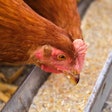There is often a question how nutrition affects the hatchability of eggs, especially in broiler breeders. This is because once an egg is laid, its ability to become a viable broiler chick is not guaranteed.
Fertility can be influenced indirectly by nutrition, and even a fertile egg may fail to yield a viable chick if this egg is missing certain nutrients. Beyond nutrition, of course, it is assumed that conditions during egg collection, storage, and setting are optimal.
Broiler fertility, weight
Broiler fertility is influenced in a negative way by obesity. An overweight male or female bird will always be more reluctant to mate as age progresses than a bird kept near its recommended size for its age. In a Canadian study, female broiler breeders that were about 500 grams lighter than recommended weight, during the end of the laying period, were more fertile (by 2-4 percent points) than females that were maintained at standard body weight condition.
Today, it is frequently recommended to closely monitor and control broiler body weight after the peak of production to reduce the rate of decline in fertility due to age. This can be achieved by controlling broiler feed composition or its daily allowance. Naturally, the same guidelines apply to male broiler breeders to maintain a high mating activity and reduce the decline in sperm quality that comes with advanced age.
Critical feed vitamins
Hatchability also can be affected by the concentration of vitamins in the broiler breeder feed. For example, a complete omission of riboflavin results in zero hatchability after seven weeks. However, seven weeks to diagnose such a problem is not advisable. Instead, a sudden increase in the midterm embryo death rate (7-14 days) is used as a quick-response index to determine if there is a problem with the vitamin nutrition of the broiler breeders.
Vitamin deficiencies can occur if the vitamin premix is omitted inadvertently during broiler feed preparation, or if some vitamins are omitted by the manufacturer. In addition, most vitamins are quite sensitive and prone to destruction and their potency can be severely reduced during feed manufacturing or storage.
In this case, a mild deficiency is more likely to occur and as such it is quite difficult to diagnose properly. Nevertheless, it is important to determine quickly the cause of vitamin deficiency and correct the problem or increase that vitamin's concentration in the broiler premix.
Egg size, feed intake
Finally, hatchability can be affected by egg size, which is influenced by feed intake and certain nutrients such as methionine.
Under normal conditions, a hen will deposit a standard 2 grams of calcium per egg, regardless of its size, even if she has to draw such calcium from her bone reserves. As a result, larger eggs will have thinner shells than smaller eggs. Eggshell thickness affects the exchange of gases during incubation. If the incubator humidity is not adjusted properly, this might affect hatchability to a varied degree. Eggs with thin shells also are quite prone to cracking during handling, storage and incubation.

















